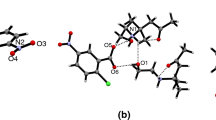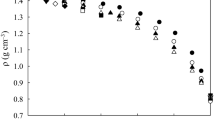Abstract
The mechanism of the azeotropy phenomenon has been established at a molecular level for the first time on the example of the HCOOH–H2O system, which has an azeotropic region. The studies are based on the regularities of the formation of heteroassociates with strong hydrogen bonds in binary systems and on the assumption that both phases of a boiling azeotropic mixture are composed of the same heteroassociates. It has been established that an aqueous formic acid solution is azeotropic if the heteroassociates composing this solution at room temperature are converted under heating into the most stable of possible heteroassociates 2НСООН ∙ 2Н2О and 2НСООН ∙ Н2О, which are retained at boiling temperature. Such restructuring in the solution leads to the maximum strengthening of intermolecular interactions and occurs with minimum energy expenditures.


Similar content being viewed by others
REFERENCES
The Concise Chemical Encyclopedia, Ed. by I. L. Knunyants (Sovetskaya Entsiklopediya, Moscow, 1961), Vol. 1 [in Russian].
V. B. Kogan, V. M. Fridman, and V. V. Kafarov, Liquid–Vapor Equilibria (Nauka, Moscow/Leningrad, 1966) [in Russian].
T. Ito and F. Yoshida, J. Chem. Eng. Data 8, 315 (1963).
V. A. Durov and E. P. Ageev, The Termodynamic Theory of Solutions (URSS, Moscow, 2018) [in Russian].
S. K. Ogorodnikov, T. M. Lesteva, and V. B. Kogan, Azeotropic Mixtures (Khimiya, Leningrad, 1971) [in Russian].
W. Swietoslawski, Azeotropy and Polyazeotropy (Ed. by K. Ridgway. London A Pergamon Press, 1968).
J. E. Brady, General Chemistry: Principles and Structure (Wiley, New York, 1990).
R. P. Currier, T. B. Peery, M. F. Herman, et al., Fluid Phase Equilib. 493, 188 (2019). https://doi.org/10.1016/j.fluid.2019.04.006
M. Ferreira and C. E. Schwarz, J. Chem. Eng. Data 63, 4614 (2018). https://doi.org/10.1021/acs.jced.8b00680
Yu. A. Pisarenko, Russ. J. Phys. Chem. A 82, 1 (2008). https://doi.org/10.1134/S0036024408010019
L. A. Serafimov, A. K. Frolkova, and L. A. Khakhin, Tonkie Khim. Tekhnol. 9 (4), 45 (2014).
T. Kim, H. Kaneko, N. Yamashiro, and K. Funatsu, Jpn. J. Comput. Chem. 11, 112 (2012). https://doi.org/10.2477/jccj.2011-0028
V. Mazur, S. Haddad, and D. Nikitin, J. Appl. Solution Chem. Model. 3 (1), 1 (2014). https://doi.org/10.6000/1929-5030.2014.03.01.1
J.-N. Jaubert, R. Privat, and N. Juntarachat, J. Supercrit. Fluids 94, 17 (2014). https://doi.org/10.1016/j.supflu.2014.06.014
G. M. Platt, R. P. Domingos, and M. O. de Andrade, Comput. Sci. Discov. 7 (1), 1 (2014). https://doi.org/10.1088/1749-4699/7/1/015002
N. P. Komninos and E. D. Rogdakis, Fluid Phase Equilib. 494, 212 (2019). https://doi.org/10.1016/j.fluid.2019.04.017
Wang Dong, Yang Bin, Xu Baoqiang, and Yang HongWei, Vacuum 166, 206 (2019). https://doi.org/10.1016/j.vacuum.2019.05.005
A. Wakisaka, K. Matsuura, M. Uranaga, et al., J. Mol. Liq. 160, 103 (2011). https://doi.org/10.1016/j.molliq.2011.03.002
I. A. Kirilenko, Water–Electrolyte Systems (Krasand, Moscow, 2017) [in Russian].
I. A. Kirilenko, Russ. J. Inorg. Chem. 63, 1728 (2018). https://doi.org/10.1134/S0036023618130053
G. V. Yukhnevich, E. G. Tarakanova, and S. I. Kargov, Russ. Chem. Bull. 61, 1079 (2012).
E. G. Tarakanova and G. V. Yukhnevich, Russ. J. Inorg. Chem. 63, 549 (2018). https://doi.org/10.1134/S0036023618040216
E. G. Tarakanova, G. V. Yukhnevich, I. S. Kislina, and V. D. Maiorov, Phys. Wave Phenom. 28 (2) 168 (2020). https://doi.org/10.3103/S1541308X2002017X
E. G. Tarakanova, G. I. Voloshenko, I. S. Kislina, et al., J. Struct. Chem. 60, 266 (2019). https://doi.org/10.1134/S0022476619020100
V. D. Maiorov, G. I. Voloshenko, I. S. Kislina, and E. G. Tarakanova, Russ. J. Phys. Chem. B. 14 (1), 5 (2020). https://doi.org/10.1134/S199079312001008X
ACKNOWLEDGMENTS
The authors are profoundly grateful to V.A. Lotkhov for useful consultation.
Funding
This work was financially supported by the Russian Foundation for Basic Research (project no. 19-03-00033).
Author information
Authors and Affiliations
Corresponding author
Ethics declarations
The authors declare that they have no conflicts of interest.
Additional information
Translated by E. Glushachenkova
Rights and permissions
About this article
Cite this article
Tarakanova, E.G., Kirilenko, I.A. Mechanism of the Azeotropy Phenomenon in Aqueous Formic Acid Solutions. Russ. J. Inorg. Chem. 65, 1591–1595 (2020). https://doi.org/10.1134/S0036023620100204
Received:
Revised:
Accepted:
Published:
Issue Date:
DOI: https://doi.org/10.1134/S0036023620100204




